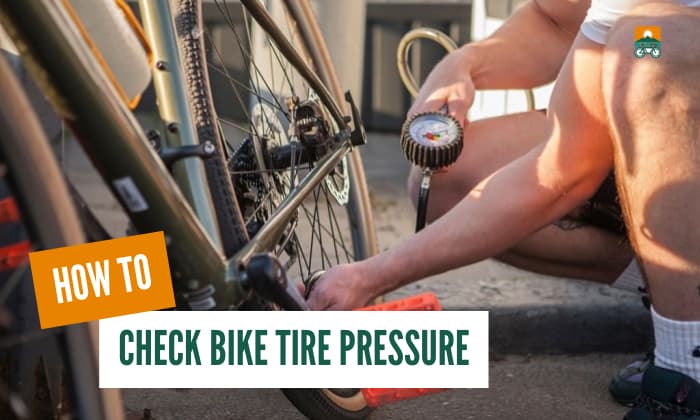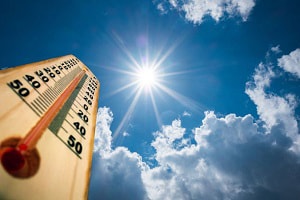Every bicycle owner needs a pump for their tires, and it is important to have the tire filled up properly. This means you also need to know how to check bike tire pressure to ensure that you are maintaining the proper PSI for your wheels.
We’ll take a look at two common ways to determine whether bicycle tires have the right pressure. There is also useful information to uncover, such as considerations for inflating tires and a PSI chart for different bike types.
Keep reading to learn more.
Table of Contents
Ways to Check PSI on Bike Tires
Using a bike tire pressure gauge is the most accurate way of checking your tire’s firmness. They are also easy to use—if you know how to use a bicycle pump, you should be able to use these without trouble.
While some bicycle pumps have gauges, many are inaccurate because they measure the pressure inside the pump instead. Measurement with pump is better than nothing, but using a specialized pressure gauge is still better.
- First, choose a gauge compatible with your tire valve (either Presta or Schrader). Note that it should cover the pressure range of your tire as well.
For instance, if the required pressure for your tire is 92–116 PSI, the gauge must cover 50 to 200 PSI, given that the device is most accurate within the middle of its range.
- Remove the cap of your tire valve. You’ll also need to unscrew the nut at the top if you have a tire with Presta valve.
- Place the gauge or its nozzle onto the valve; doing this is enough to let the pressure into the device. Check the gauge for your pressure reading.
- Once you’re done, press the reset button if there’s any.
In case you have no pressure gauge, you’ll have to observe the tire’s firmness to check its pressure. Ideally, you should be familiar with how firm the tire is when it’s at the ideal PSI level.
You can do this by feeling the tire every time you pump it at the ideal setting. This will give you the familiarity you need.
- To check it by hand, grasp the tire with both thumbs on one side and your other fingers on the other. Press with your thumbs and observe its firmness.
- Another way to check the tires’ firmness is by getting on your bike.
Once you’re on the saddle, observe the tire’s compression. If it is soft enough that you can see it stick out from the rims, then it lacks pressure. However, if it is entirely stiff, there’s too much air in the tire.
Bicycle-specific Pressure Measurement
How full should bike tires be? Tire pressure is measured in pounds per square inch or PSI, and different cycles have their own ideal measurements. The recommended PSI range changes based on tire width as well, as seen in the bicycle tire type pressure chart below.
Road bike tire pressure tends to be higher to reduce roll resistance, while MTB tire pressure is on the lower side to provide better grip and traction.
Some bicycles have a wider range of PSI. For example, BMX tire pressure is more heavily influenced by the activity it will be used for. Similar to BMXs, hybrid bike tire pressure is also adjusted based on what you will be doing.
| Bicycle Type | Recommended PSI |
| Road | 92 – 116 (23mm)
80 – 104 (25mm) 72 – 96 (28mm) 63 – 84 (30 mm) |
| MTB | 18 – 26 (2.1in)
17 – 25 (2.25in) 16 – 31 (2.4in) 14- 23 (2.6in) 14- 22 psi (2.8in) |
| BMX | 75 – 85 (dirt jump)
55 – 75 (street) 80 – 100 (park) |
| Hybrid | 30 – 50 (mountain)
60 – 80 (road) 70 – 90 (dirt and gravel) |
| Children’s | 18 – 36 (MTB)
30 – 60 (Hybrid) |
| Commuter | 50 – 80 (35mm)
40 – 70 (38mm) |
| Fat | 4 – 7 (3.8 – 4in)
3.5 – 6.5 (4.5 – 4.8in) 2.5 – 5.5 (5in) |
Things to Consider for Inflating Bicycle Tires
Here are a few other things that you should consider when you are checking your tire pressure and trying to work out the right level.
1. Manufacturer-endorsed PSI
While there are general PSI recommendations for bike types, tire manufacturers usually have their endorsed PSI as well. These can be found printed or embedded at the side of the tire, indicating a range instead of a specific measurement.
2. Cyclist weight
The weight of both the rider and the bike affects the ideal tire pressure. Check to see how certain PSI settings feel and observe the level of compression on the tire. A heavier weight will require a higher pressure to balance it out.
3. Front and back tire pressure
Weight is a point to consider, but it’s not just how light or heavy you are; the distribution is also important. The rear typically bears around 60% of the rider’s weight, but this also differs between people.
Allow the rear to have a bit more pressure compared to the front using a bit of trial and error to see what works.
4. Temperature
A commonly overlooked factor that impacts tires’ pressure is the temperature. For instance, if you bring your bike to a place 10℉ colder, the tire’s temperature will drop 10 degrees as well.
So, how does this temperature change impact the tire pressure? With every 10-degree change in temperature, there will be a 2% fluctuation in the tire’s PSI rating. To be clear, warmer weather will increase tire pressure, and colder climates will decrease it.
Different Types of Bicycle Pumps
Here are the different types of bicycle pumps. Among them, only three usually sport a pressure gauge: the stand, foot, and electric pumps.
- Stand pump: a long tubular pump that can reliably fill a tire more efficiently.
- Foot pump: a foot-operated tool that is more portable but less efficient compared to stand types.
- Hand pump: small enough to keep inside a bag during travel but requires much time and effort. It cannot be used for high-pressure inflation.
- Frame pump: this is designed to hold onto the bicycle’s frame, making it easy to keep along with the bike. Similar in operation to hand pumps but bigger.
- CO2 inflator: compact but can quickly fill a tire and is good for emergencies. However, CO2 also leaks out more easily.
- Electric: Motorized inflation is convenient but challenging to carry around and has limited battery life.
Frequently Asked Questions
How often should I check my bike tire pressure?
Many of us only bother to check once bike tires look flat when riding. However, there is merit in making this part of your routine.
How often to check tires also depends on the type of bicycle. Road bikes need to be checked more frequently, but the more durable MTBs can be checked every few weeks instead. Ideally, we should check them before every ride.
How do you determine the correct tire pressure?
There are various ways on how to know the tire pressure that works; we have the manufacturer’s recommendation and the PSI chart. However, an accurate measurement is difficult to get because this involves various factors.
The right 26-inch mountain bike tire pressure differs from that of a 27-inch one. Not to mention that even two tires with identical sizes might still need different PSI due to varied rider’s and frame’s weight.
An easy but accurate way is to use a bicycle tyre pressure calculator, which you can find several online.
What happens if the bicycle does not have the right pressure?
Many problems can arise if there is too much or too little air in a bicycle tire. If your tire pressure is too high, there is an increased risk of the tube popping. It can also result in tires that bounce too much.
Too-low pressure can also result in damage to the tires, in addition to unnecessarily increasing the roll resistance, making it more difficult to ride. Be especially careful when dealing with PSI for hybrid bike tires and BMX, since they have a wider range to work with.
Conclusion
Now you know how to check bike tire pressure for your ride. Remember to include this in your pre-ride routine, and you’ll not only benefit from better performance, but you’ll be safer and less prone to cycling problems as well.
Do you think it is necessary to have an accurate PSI for tire pressure? What do you consider most important when determining the firmness of your tires? Tell us what you think in the comments section below.

“I ride my bike to work for years, but is that enough? Our carelessness towards our surroundings has taken a toll on the environment. And now, everyone is responsible for changes; even the most minor contribution is counted. With this hope and spirit, I started with my partner to establish Biketoworkday to help more individuals commute to their work sites on their bikes.”










